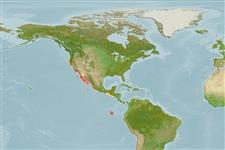Common names from other countries
>
Aulopiformes (Grinners) >
Synodontidae (Lizardfishes) > Synodontinae
Etymology: Synodus: Greek, syn, symphysis = grown together + Greek, odous = teeth (Ref. 45335).
More on author: Ayres.
Environment: milieu / climate zone / depth range / distribution range
Ecología
marino asociado a arrecife; rango de profundidad 1 - 229 m (Ref. 2850), usually 2 - 50 m (Ref. 9348). Subtropical; 51°N - 2°S, 128°W - 88°W
Eastern Pacific: San Francisco, USA to Cabo San Lucas and Guayamas, Mexico. Reported from British Columbia (Ref. 11980) and the Galapagos Islands (Ref. 5227).
Tamaño / Peso / Age
Maturity: Lm ? range ? - ? cm
Max length : 64.0 cm TL macho / no sexado; (Ref. 9348); common length : 30.0 cm TL macho / no sexado; (Ref. 9348)
Espinas dorsales (total): 0; Radios blandos dorsales (total): 11-13; Espinas anales 0; Radios blandos anales: 12 - 15; Vértebra: 60 - 63. Most species are brown to gray or red dorsally and laterally and pale ventrally; some species have a pattern of dusky saddles, lateral spots, or bars (Ref. 35938).
Perch motionless on pectoral fins in a wide range of habitats; commonly found on sandy bottoms or sand patches around rocky reefs and boulder and gravel strewn slopes. Active during the day. May bury in sand with only the eyes and mouth protruding (Ref. 5227). Feed on fishes (Ref. 9348). Oviparous, with planktonic eggs and larvae (Ref. 35938). Extended larval period (Ref. 35938). Catches are either discarded or made into fish meal (Ref. 9348).
Life cycle and mating behavior
Madurez | Reproducción | Puesta | Huevos | Fecundidad | Larva
Oviparous (Ref. 35938). Also Ref. 240.
Eschmeyer, W.N., E.S. Herald and H. Hammann, 1983. A field guide to Pacific coast fishes of North America. Boston (MA, USA): Houghton Mifflin Company. xii+336 p. (Ref. 2850)
IUCN Red List Status (Ref. 130435)
Can't connect to MySQL database (fbapp). Errorcode: Too many connections
